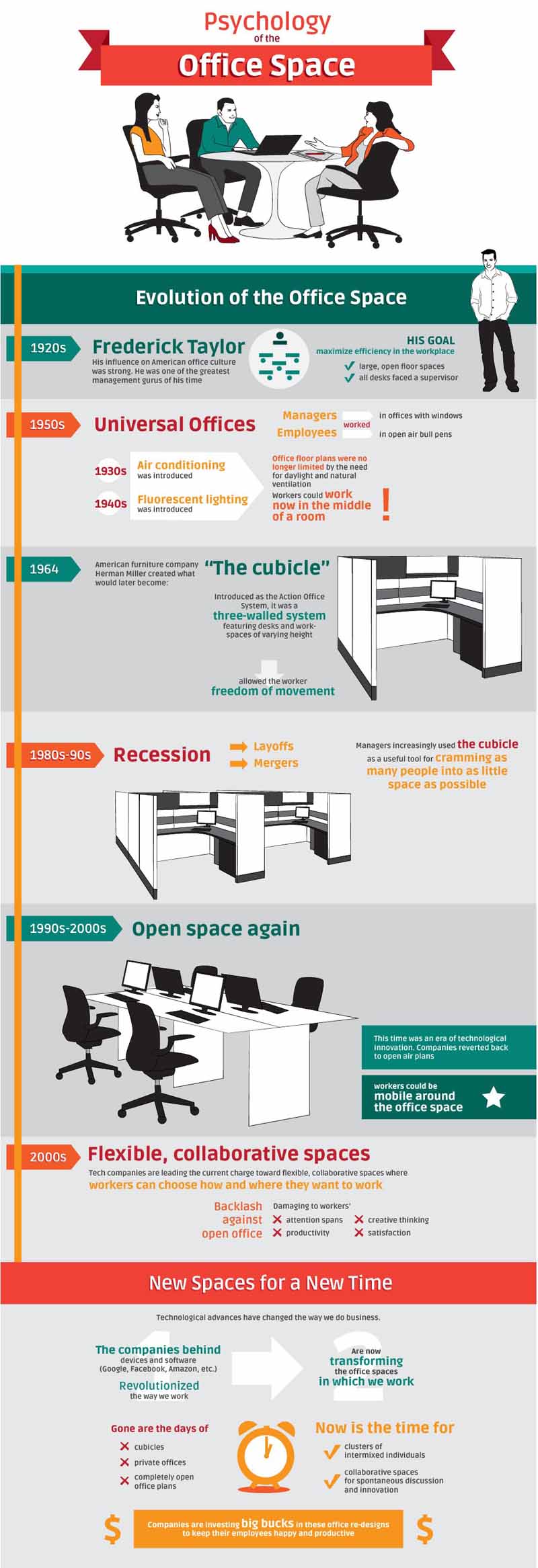Contributed by Robert Conrad
Some newer entrants into the office space may think that open floor plans and collaborative areas have been the norm since the beginning of time. This, however, is simply not the case. The currently accepted norm of an office space’s construct encourages collaboration as well as private brainstorming free of distractions, but it is not a new concept; it’s just a new spin on a concept created by Frederick Taylor.
From Taylor’s original supervisor-facing, open floor plan to the death of the cubicle, this infographic, provided by the the University of Southern California, discusses the pros and cons of each era of the office space’s evolution and “the who and what” that has spearheaded the revolution of change.
Robert Conrad, contributor of this post, is a former Business student that graduated with a 3.91 GPA. He has also worked in a couple of different office environments that practiced both cubicle and open air formats, but never a blending of the two. When he punches out for the day, he enjoys playing video games and trying out new restaurants.






9 Responses
I would love to see a photo or two of some of these new office spaces. Also, I’m curious about how they accommodate to the less social, more introverted worker, or does our society basically think everyone should be the same way – social and collaborative – and not accommodate these personalities at all?
I did find an article that shows off these new office layouts: http://blog.sandglaz.com/ultimate-office-layouts/.
From what I’ve researched, tech companies like Google and Foursquare are going with a blending of isolated workspaces and collaborative areas. I couldn’t imagine an introvert being forced to work in a 100% collaborative work environment, and I’m glad that companies like these are embracing their employees’ personal preferences.
Thank you for the comment, Peggy!
Ah ha! Thanks for sending that along. I see that it really varies from company to company and that they seem to offer a few options.
The problem is that the private, quiet workspaces are temporary, and require employees to abandon their monitors and ergonomic setups for working on laptops with dinky screens and tiny keyboards. While the younger worker doesn’t notice the issue (yet), the long time tech worker with RSIs is faced with a dilemma: not hurt yourself and have low productivity in the hubhub area, or injure themselves more in the private hideouts to get any actual work done. Having temporary private hideouts only works for people who do not require ergonomic or psychological accommodations. This is ableist at best.
Great point. To accommodate both types of workers, then, workers should be given a choice of permanent office space – private or social – and then be free to move into the other as needed.
I had worked in a call center in the past that didn’t make accommodations for folks with RSIs. It was quite depressing to see 20-somethings walking around with arm braces on, granted, but from what I’ve gathered, the trend for office environments seems to be shifting towards employee satisfaction through meeting their needs, regardless if the environment is exclusively collaborative, private or both.
It would be unreasonable for a manager to assume that workers who require accommodations to be at their best would achieve the same stellar results when their needs aren’t being met, and I’m glad that companies like Google and Foursquare are ushering in a new era where employee comfort is a top priority.
Thanks for reading!
Interesting read. We had an open space area that was also unassigned; you sat in a different spot and with different people everyday. Naturally, over time we would gravitate to our “favourite” spot — much like the cafeteria back in high school. I had trouble adjusting at the very beginning: setting up everyday, packing up every evening, the level of noise, the very necessary reduction of paper (since we had very little storage for anything paper-based), and, of course, disinfecting your workstation to reduce the spread of germs.
Over 5 years later, we were given a choice of an assigned seat in a cubicle. I opted out. I like being “green”; I’ve trained myself to block out chatter; I enjoy the spontaneous brain-storming with my colleagues; sharing a joke with one person means you’ve shared it with a dozen–everyone gets in on the fun.
The open space isn’t for everyone but if you do try it and like it, it can potentially create a very engaged environment.
Thanks for sharing. It’s interesting that you weren’t a fan of the open plan at first but you adjusted. It’s good advice to suggest that people try to adapt. Most of us can if we try.
I’m glad that you were able to adapt to your new environment, Linda! I would struggle myself if I were thrust into a different position with different people over time. However, a lot of positive things can be said about the collaborative nature of an open-office environment. At my old job, I used to constantly get rotated to a new team every 2 months, which put a damper on an long-term friendships that could have been, and was only exacerbated by the use of cubicles! :-/